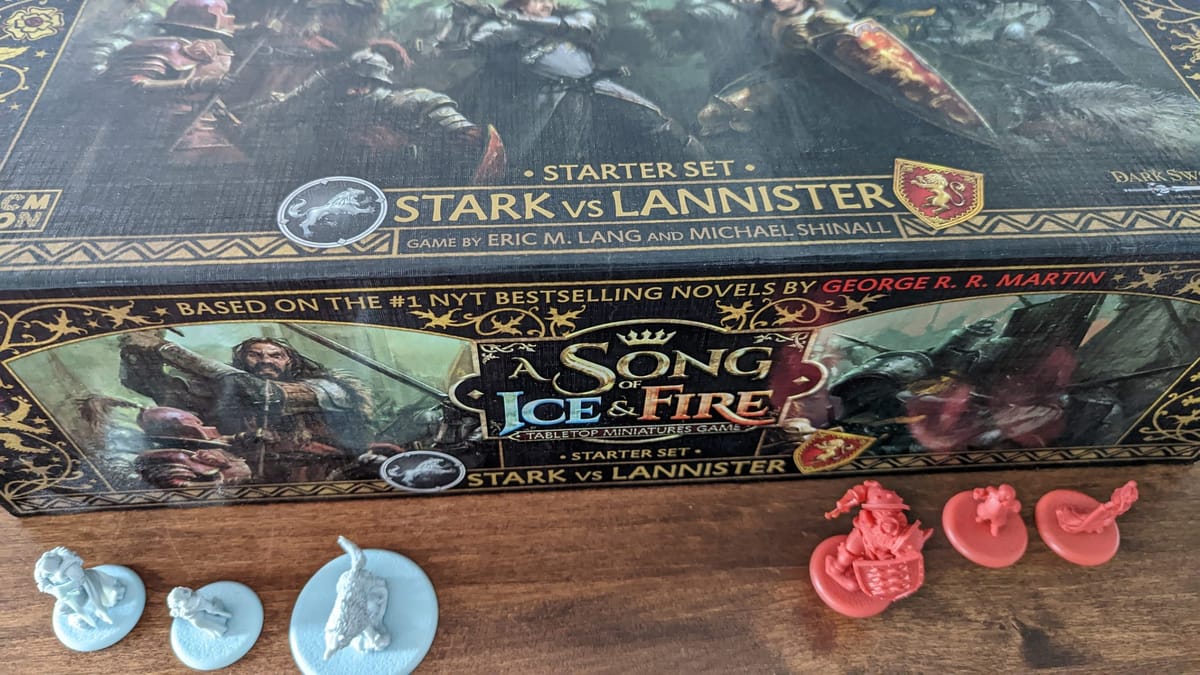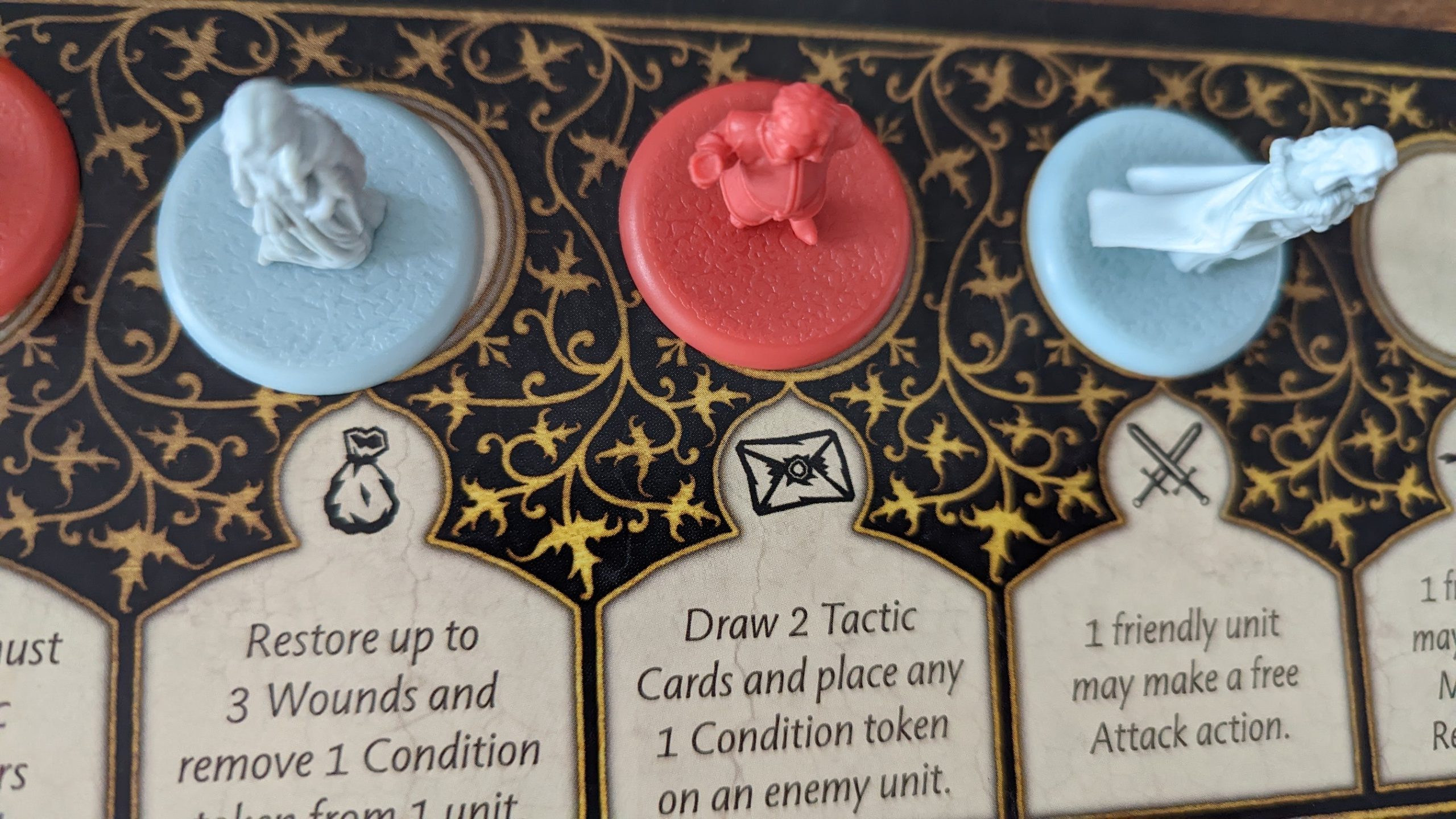
When this game first debuted a few years ago, I dismissed it out of hand. I was fatigued on the IP, and while Eric Lang certainly had the board game design pedigree, that didn’t necessarily translate to wargaming, so I cynically took it as CMON slapping their biggest design name onto their largest IP name, and decided to pass on the title. It certainly didn’t help that I had burned out on large-scale war games and had downsized to squad level games, but it was what it was. And boy, was it a mistake, because this could easily be my favorite miniatures game, if not the most unique.
The selling point here is the tactics board, another thing I was suspicious had been tacked-on to integrate characters like Cersei and Sansa that wouldn’t make sense to integrate onto a battlefield. Mechanically, it functions as a secondary worker placement game- ASOIAF uses alternating activations, and while the vast majority of these will be used on combat units, players with a non-combat unit (NCU) can opt to instead activate it to claim an empty zone on the tactics board and utilize that zone’s effect. Players also have access to their tactics decks, which will be comprised of their faction’s base cards combined with their commander’s. These cards have powerful effects and triggers that indicate when they are played, ranging from when a unit attempts an attack to when you claim or have control of a specific zone of the tactics board. Most factions have zones they tend to prefer over others – Lannisters, for example, like to have control of the crown to play some of their best cards. This introduces interesting gameplay choices where a player may not personally care about a particular part of the tactics board, but is still incentivized to fight for control of it to deny it from their opponent. In most worker placement games, performing an action you don’t need just to mess with another player is usually suboptimal, but there are NCU abilities and tactics cards that can replace a zone’s effect with a more desirable alternative, meaning throwing a wrench in your opponent’s plans is always a valid option.

At first, I was worried that adding worker placement and hand management to a miniatures game would make it convoluted, but each portion has been stripped down to just the right level of complexity so it can provide an interesting decision space without being overwhelming. This is especially noticeable in combat, where most minis games require their best players to memorize a doctoral thesis’ worth of obscure rules- but here, combat units simply perform one of five actions when activated. Keywords exist in that sweet spot where they only exist to shorthand a handful of recurring abilities that the community would have informally keyworded anyway. Similarly, there are only three conditions in the game, each tied to one of the three times players will be rolling multiple dice. List building is a similarly simple and enjoyable experience of discovering the synergies between different units and tactics cards, streamlined through the excellent companion app. All this ties together into a game that looks like it’s from a sci-fi universe from the outside, but is easy to teach and learn in practice.

Unfortunately, I wouldn’t feel like I did my job as a reviewer if I didn’t pick some nits, and this game isn’t without its faults. The large unit trays make the provided punchboard terrain necessary, which is always gonna feel kinda cheap for people used to playing with 3D terrain. If someone gets a low result on their charge distance roll, the charging unit performs a disorderly charge and it shoots itself in the foot, bringing along a feel-bad moment and extra bit of rules that the game doesn’t really need. The game comes with multiple game modes, but all of them except the basic Game of Thrones adds extra rules complexity that doesn’t actually serve to enhance the play experience. Last, the box only comes with enough plastic for a small 30-point game, requiring additional buy-in if players want to play the standard 40-point size, but that’s just an unfortunate industry standard.
In the end, I won’t be holding onto my review copy of this starter set, but that’s only because I’m giving it to a friend so I can explore the other houses, especially the recently released Martells.
A Song of Ice & Fire: Tabletop Miniatures Game
Excellent
The A Song of Ice and Fire Miniatures game is an interesting blend of large-scale minis warging and worker placement that will appease both fans of the IP and fans of the hobby in general.
Pros
- Both the fighting boys on the battlefield and the NCUs on the tactics board require the players' attention, but neither is complex enough for it to be overwhelming
- As per usual, CMON's minis are high-quality
- There's a lot of room here for players to find a faction and synergies within it that appeal to their favorite playstyle
Cons
- The punchboard terrain feels cheap, especially next to the minis
